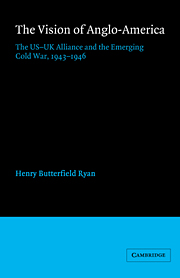Book contents
3 - The mixing process
from PART I - STRENGTHENING THE TIES: THE EFFORT AND THE PROBLEMS
Published online by Cambridge University Press: 07 December 2009
Summary
To create the new power, Anglo-America, it was necessary to get affairs of the United States and Great Britain ‘mixed upy’, as Churchill put it, a phrase uttered frequently by British officials at the time. In January 1943 a blaze of comment in this regard went through the Foreign Office when an article by Walter Lippmann came to its attention saying that it and the State Department were further apart in their views than were the populations of their two countries. Gladwyn Jebb, head of the Economic and Reconstruction Department, had circulated the article with the comment, ‘I'm all for the Foreign Office and the State Dept. getting “mixed up”, and I think visits by Heads of Depts. on both sides ought to be arranged.’ Eden agreed, saying, ‘we must improve contacts between FO and State Dept. at all levels. These are frankly deplorable at present.’ He concurred with Jebb's suggestion for exchange visits, adding, ‘I hope that this process can be set going now.’ Within two months, Eden himself, in fact, went to Washington to begin the ‘mixing’ process.
But running counter to that process was the American suspicion of things British and the related phenomenon of isolationism. Even if these currents were by then on the wane, the US Administration, as noted earlier, showed great respect for their troublemaking potential. Furthermore, implicit in plans to entwine the State Department and Foreign Office was the notion that they would mix principally in the field of postwar planning.
- Type
- Chapter
- Information
- The Vision of Anglo-AmericaThe US-UK Alliance and the Emerging Cold War, 1943–1946, pp. 39 - 53Publisher: Cambridge University PressPrint publication year: 1987



